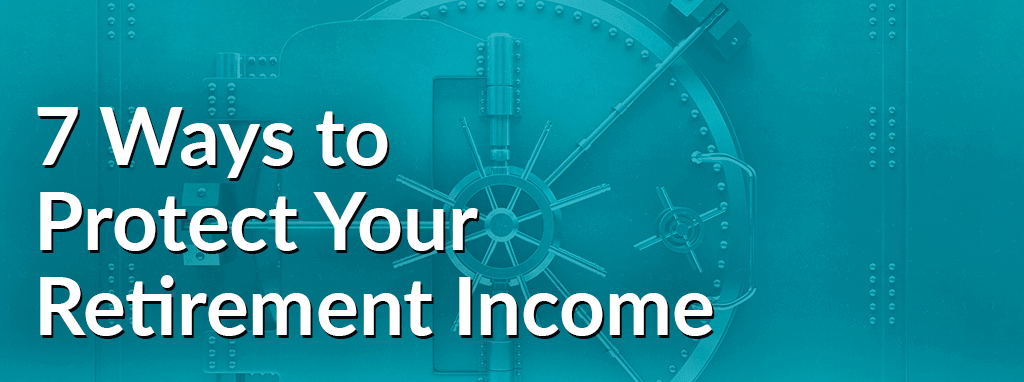Most of us look forward to retirement, imagining we’ll get to relax and enjoy the activities we didn’t have time for during our working years like traveling, eating out more often, and enjoying our favorite hobbies. However, as hard-working Americans transition into retirement, many don’t realize they’re crossing the threshold into a new way of living, where they might be vulnerable to risks unique to retirees.
After spending decades working toward a goal and practicing Retirement Strategies for High-Income Earners, too many retirement plans are set back by these risks. That’s why we’ve taken the time to identify 7 ways to help protect your retirement income from these easy-to-avoid risks.
1. Do Not Underestimate How Long You Might Live
According to United Nations estimates in 2015, the world was home to nearly half a million people who were 100 years of age or older—with projections suggesting there will be 3.7 million people around the world who make it to age 100 in the year 2050.1
What if you are one of the lucky ones who gets to enjoy 35+ years in retirement? If you fail to plan for such a long retirement, you could end up outliving your retirement savings. Once people realize they might need to have a financial plan capable of providing income for that long, they understand how important the decision of where to put retirement money after retirement becomes. For many, the right answer is in income-generating investments designed to help lower risk and provide steady interest and dividend payments—instead of traditional growth-based investments that can carry a higher risk of loss.
2: Avoid Spending Principle
Spending principal in retirement has never been a smart strategy. However, with life expectancies on the rise, it’s a more slippery slope than ever before, especially for those in their early years of retirement. To understand the potential dangers of spending principal, let’s consider a 30-year retirement like a 30-year mortgage in reverse.
When you first start making mortgage payments, you’re not paying back much principal at all. Instead, you’re paying primarily interest and only a small amount of principal. As the years go on and the balance gets paid down, you pay a little less interest and a little more principal. The process continues until, after 30 years, your mortgage is paid off.
Now, let’s imagine the same process in reverse. Take a pool of savings worth $1 million, generating 4% interest per year, or $40,000. If you take even just a little bit more than the $40,000 each year, just a small amount of your original principal, your $1 million in savings will be depleted within 30 years in much the same way that a mortgage is paid off.
So, as you consider how to help protect your assets in retirement, you will want to consider a plan capable of generating enough in interest and dividend payments, so you can help avoid tapping into the principal balance of your retirement savings for as long as possible.
# 3: Have a Plan to Help Offset the Power of Inflation
It’s no secret that inflation has the potential to eat away at the purchasing power of your money. The Bureau of Labor and Statistics estimates the average rate of inflation is right around 3-4% per year.
What many people don’t realize is that the rate of inflation on the things you’ll need during retirement, like healthcare, can easily exceed the normal rate of inflation This means that if you retire today in your 60s, and live 30 years or more into retirement, you will likely need more income at the end of your retirement as you did on your first day. So, as you consider how to help secure your retirement, an important step is to help to ensure that your retirement plan is designed to help protect your savings so you can use it to generate income well into retirement…which brings us to tip #4.
# 4: Reduce Your Exposure to Stock Market Risk as You Near Retirement
Taking a look back at stock market history, we see that the stock market works in cycles—with each full cycle taking about 35 years and containing both long-term secular bear and bull market cycles. What this means is that if you end up living anywhere near 30 years into retirement, you’ll probably experience a bear market. If you are still heavily invested in stock mutual funds, it could bring trouble.
For example, if you retired in 2000, you would have had to liquidate shares of your fund at a time that the price of those shares was down. Instead of buying low and selling high, which is a cornerstone principal of smart investing, you would have been forced to sell more shares at a lower price to generate the income needed. This is known as reverse dollar-cost averaging and is one of the biggest financial mistakes a retiree can make, because it could lead to the cannibalization of your retirement savings.
We are often asked: “what is the best way to help protect my 401(k) from a stock market crash? … “what are the best retirement income strategies?” and “what is the safest place for retirement money?”
Although there’s no one-size-fits-all answer, we feel that making the switch from a strategy that is focused on growth-based investments to a strategy that focuses on income-generating investments is a sensible and viable way for retirees and near-retirees to help protect their retirement savings from market risk and economic uncertainty.
Instead of crossing your fingers and hoping that your investments appreciate in value in what can be an unpredictable stock market, you could instead use what you’ve saved for retirement to generate reliable interest and dividend payments that are not dependent on stock market performance.
#5: Plan for the Possibility of Needing Long-Term Home Healthcare
A common mistake for retirees is to overlook the potential need for long-term in-home healthcare. Those who do plan for it will often make the mistake of using the current prices for healthcare at the time they retire to formulate their plan for handling these future costs. Unfortunately, as we mentioned earlier, the rate of inflation on the things you’ll need during retirement, like healthcare, can easily exceed the usual inflation rate.
According to Genworth Financial’s Cost of Care survey, that average cost for home health care is $4,385 per month. Keep in mind that the cost of care can vary depending on where you live, and the level of care required. This survey also indicates that 7 out of 10 people will require some sort of long-term care.2
This means that all retirees should have a plan in place to address the potential need for some sort of long-term care. Although the current cost of home healthcare is about $52,000 per person each year, after accounting for inflation, that cost could be much higher by the time many of us reach our 80s and 90s.
#6: Keep Up with Changes in Policies for Government Programs
For the first time since 1982, the Social Security program’s costs exceeded its income in 2018, forcing the program to dip into its $3 trillion trust fund to cover benefits. After 2034, the Social Security Administration projects that if the system is not reformed, benefits will have to be reduced.3
The reality is, whether Social Security is reformed or not, it was never intended to provide all the income individuals need to enjoy a comfortable retirement. Instead, most would agree that Social Security needs to be considered in the context of your other retirement resources such as your 401(k)s, IRAs, and other savings.
By working with an advisor who is experienced in helping clients navigate the complexities of planning and saving for retirement, you can be sure to keep up with the best ways to help maximize your Social Security benefits. Other risks related to changes in government programs include changes to tax laws, increases in property tax rates, and Medicare benefit changes.
#7: Plan for the Unexpected
Life can throw us curveballs, but with a little pre-planning, retirees can be better prepared for whatever lies ahead. A couple of examples of unexpected events that can wreak havoc on people’s retirement plans include the loss of income due to the death of a spouse, as well as having to care for elderly parents and/or dependent children. Although it can be difficult to plan for every potential unexpected event, a financial plan built to generate consistent income can go a long way in helping you deal with the unexpected.
One of the biggest sources of stress between spouses and within a family is financial stress. Think about it: if every time an unexpected expense arises you have to worry about where the money will come from, it can place added stress on your relationship.
However, if your retirement savings is generating steady interest and dividend payments, it can provide you with a little financial breathing room. In addition to helping you deal with the unexpected, investing for income can also help you enjoy more of those fun activities you may not have had the time to enjoy during your working years without having to second guess every expense.
These are just a few reasons why a retirement plan focused on Investing for Income can be a viable way for hardworking Americans to achieve the retirement they truly deserve. If you are interested in learning more about Investing for Income, check out our recent blog post: Investing for Income vs. Growth.
Also, if you are ready to start enjoying the greater sense of consistency that Investing for Income can provide, click below to schedule a free, no-obligation consultation with an Income Specialist near you.






